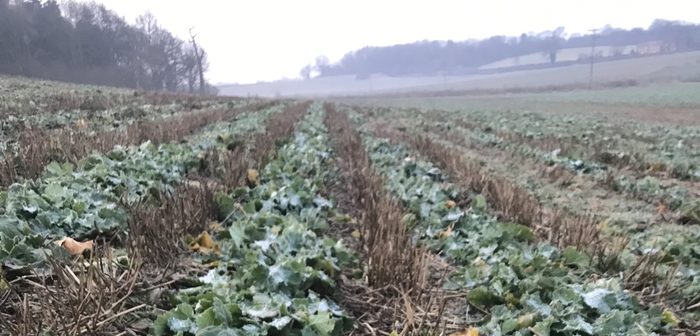A “little and often” approach to spring fertiliser applications and tailored use of growth regulators are two important ways growers can help oilseed rape crops fulfil their promising yield potential this season, agronomy firm Farmacy says.
Crops have generally come through the mild winter in good condition, with low disease pressure from phoma and light leaf spot and good weed control, resulting in many that are well forward, with strong root and canopy growth, says Norfolk-based Farmacy agronomist Peter Riley.
“Some have struggled where they were hit by cabbage stem flea beetle and dry seedbeds last summer and autumn, but on the whole oilseed rape looks really well in this region. The focus is now on how we manage fertiliser applications and growth regulation to fulfil this potential.”
Fellow Farmacy agronomist Jason Noy, who looks after crops in Cambridgeshire/ Hertfordshire and further West in Wiltshire and Gloucestershire, says the first nitrogen has been applied to some early-sown crops that were beginning to look “hungry”, in order to ensure early development is not constrained.
“This is particularly true in the East where we’ve tended to drill oilseed rape very early in the first or second week of August due to flea beetle pressure. Many crops had used up the standard dose applied at drilling, so received 45kg/ha in early February.
“Even further West where rape hasn’t been drilled so early, crops will benefit from nitrogen if it hasn’t already been applied. We don’t want to generate massive crop canopies, but equally we have to ensure the crop is not starved of nutrients.”
He reminds growers of the need to tailor spring fertiliser to achieve the established target of a green area index of 3.5 by flowering and to monitor crops closely as spring growth gathers pace.
Stagger fertiliser applications
After the first dose in February, the focus for remaining nitrogen is usually around the stem extension timing, but both agronomists say there are clear benefits from holding some back to apply later in the season to ensure the crop is well nourished during the important seed filling stage.
Ideally, if farm logistics, equipment and product choice allow, Mr Riley favours a four-way split, with the February application followed by another at stem extension (usually mid-March), a third at green bud stage in early April and a final dose of foliar urea at mid- to late-flowering.
“Admittedly this isn’t always possible in practice on some farms, but a lot of research shows there are benefits from this kind of approach.”
He also stresses the importance of applying sulphur with nitrogen at the main timings where required, given oilseed rape’s sensitivity to sulphur deficiency.
“Oilseed rape requires a lot of sulphur, especially when the crop is taking up nitrogen, so I often recommend applying both at the first three fertiliser timings. Sulphur can be very mobile in the soil though so it’s sensible to apply it as close as possible to when it is needed and will be quickly taken up by the crop.”
Additional micronutrients should also be applied as required, but boron in particular is often needed by many oilseed rape crops, as deficiency can impair stem elongation and flowering, he notes.
Growth regulators
Creating a canopy structure that maximises light interception throughout the growing season is key to optimising oilseed rape yields and Mr Noy believes a well-timed growth regulator can benefit large, forward crops.
He favours mepiquat + metconazole at stem extension for growth regulation and height reduction, but also suggests trinexapac-ethyl can be a useful alternative for canopy manipulation and creating a more even flowering period.
The latter works by reducing the plant’s apical dominance and encouraging side branches to flower at the same time as the main stem, he explains. “If flowering is less drawn out, it increases the window for light to penetrate the canopy after flowering which helps the plant to build yield potential through photosynthesis.”
Mr Riley advises growers not to get caught out by applying growth regulators too late when crops are growing quickly in the spring.
“We sometimes find growth regulators are being applied too late, which reduces their effectiveness. Ideally they should go on at early stem extension, but sometimes they’re not actually going on until green bud stage which is too late.”
Keeping crops clean
Given that the most effective time for controlling phoma and light leaf spot is in autumn and winter, spring disease control should now focus on sclerotinia sprays at flowering, adds Mr Riley, who favours a two-spray approach including azoxystrobin and boscalid.
Prothioconazole-based products are also worth considering at flowering for both sclerotinia control and to mop up any remaining light leaf spot or phoma, he notes.
Key points
• • Stagger fertiliser applications through the growing period
• • Apply late nitrogen at mid-/late-flowering if possible
• • Include sulphur at main timings
• • Well-timed growth regulator can help manipulate canopy structure for maximum light interception
• • Two flowering sprays for sclerotinia recommended.




